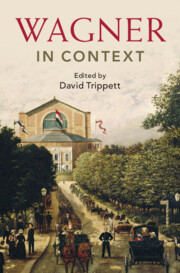Book contents
- Wagner in Context
- Composers in Context
- Wagner in Context
- Copyright page
- Contents
- Illustrations
- Musical Examples
- Contributors
- Acknowledgements
- Abbreviations
- Introduction
- I Place
- II People
- Chapter 9 Franz Liszt
- Chapter 10 Nietzsche and Wagner: The Logic of Contradiction
- Chapter 11 Wagner, Schopenhauer, and the World as a Phantasmagoria
- Chapter 12 Assessing Wilhelmine Schröder-Devrient: Influence, Genre, and Voice
- Chapter 13 Cosima Wagner
- Chapter 14 The Wagner Family: Rebellion, Honour, Aftermath
- III Politics, Ideas, and Bodies
- IV Life, Language, and the Ancient World
- V Music and Performance
- VI Reception
- Further Reading
- Select Bibliography
- Index
Chapter 13 - Cosima Wagner
from II - People
Published online by Cambridge University Press: 14 March 2024
- Wagner in Context
- Composers in Context
- Wagner in Context
- Copyright page
- Contents
- Illustrations
- Musical Examples
- Contributors
- Acknowledgements
- Abbreviations
- Introduction
- I Place
- II People
- Chapter 9 Franz Liszt
- Chapter 10 Nietzsche and Wagner: The Logic of Contradiction
- Chapter 11 Wagner, Schopenhauer, and the World as a Phantasmagoria
- Chapter 12 Assessing Wilhelmine Schröder-Devrient: Influence, Genre, and Voice
- Chapter 13 Cosima Wagner
- Chapter 14 The Wagner Family: Rebellion, Honour, Aftermath
- III Politics, Ideas, and Bodies
- IV Life, Language, and the Ancient World
- V Music and Performance
- VI Reception
- Further Reading
- Select Bibliography
- Index
Summary
Cosima Liszt, daughter of the composer Franz Liszt and Marie d´Agoult, rushed into an unsuccessful marriage with the composer and conductor Hans von Bülow. She wrote articles and visited cultural highlights in Berlin. In Munich 1864 she engaged in the love affair with Richard Wagner and a year later the child Isolde was born. She married him in 1870 in order to have the birth of Siegfried legalised and asked Bülow for a divorce. Her meticulous diaries of her life with him are a vital biographical source, although in them she perpetuates the traditional narrative of the autonomous male genius. After his death she took over the direction of the Bayreuth Festspiele and developed a style committed to Wagner’s performance practice. She excelled in matters of gesture, fusing singing aesthetic, gesture, and word/music relationship.
- Type
- Chapter
- Information
- Wagner in Context , pp. 131 - 138Publisher: Cambridge University PressPrint publication year: 2024

